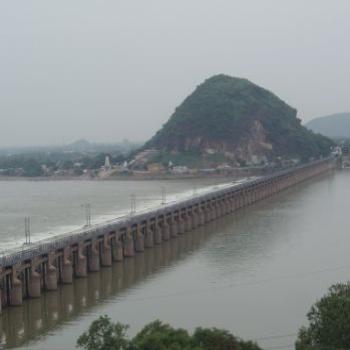
Cheras

Karikalan Chola
Though Tamil Nadu is one of the most ancient regions in India. It is only from the 4th Century B.C. that something of its history comes to light. There are references in the early Sangam literature to the social economic and religious life of the people, but there is not much on the political conditions that existed in the early centuries of the Christian era.
Most important City under latter - Madurai

Barrage across Kaveri River
Tamil Nadu was various ruled by the Cheras, Cholas and Pandyas prior to the Christian Era. Karikalan Chola, the greatest of the earlier Cholas, ascended the throne at the beginning of this era. He took several measures for the welfare of his subjects and constructed a barrage across the Kaveri River. Prominent Chola cities were Thanjavur and Kumbakonam. The Cholas were followed by the Cheras, who were succeeded by the Pandyas. Madurai was the most important city under the latter.

The Reign of the great temple builders - The Pallavas - began sometime during the second quarter of the 4th Century A.D. Dravidian, Architecture attained great heights during the Pallava periods. Some of their major contributions include the beautiful monuments of Mamallapuram, kailasanathar temple at Kanchipuram and the Kapilaswarar and Parthasarathy temples in Chennai. The most famous Pallava King was the mighty warrior Rajasimha Narasimhavarma Pallava who repelled an attack by the Chalukhya King Pulekes II, at whose hands Harshavardhana himself faced defeat. The Pallavas continued to hold sway until the 10th Century, When the Cholas under Vijayalaya and Aditya chose to assert themselves. The end of 11th Century once again saw the alternatives rule of the Chalukyas, Cholas and Pandyas. Eventually, it was the Cholas who went onto rule for the next two centuries. The two great kinds of this period were Raja Raja and Rajendra Cholas under whose reign Sumitra, Java, Sri - Lanka and Lakshadweep were Conquered to become a part of the their vast empire
The Muslim Invasion followed the decline of the Cholas and led to the establishment of the Bahmani empire in the south during the 14th Century. The other major power in the south at the time was the kingdom of Vijayanagara which absorbed the whole southern region including all the Chola strongholds by 1487. The Vijayanagara empire held sway until 1564 when it came to an end with a defeat at the hands of the Deccan Sultans in the battle of Talikota. The victorious Sultans systematically destroyed the beautiful city of Vijayanagara and the members of the Vanquished family fled far off places, The kingdom itself split into several parts and given to the Nayaks to rule. Of these, the Nayaks of Madurai attained popularity. The other important Nayak citadel was Thanjavur, but it later fell to the Marathas.
Tamil Nadu under the nayaks was peaceful and prosperous. Culturally too, it blossomed as the rulers went about renovating and reconstructing some of the oldest temples in the State. Among some of their contributions are the Tirumalai, Nayakkar Mahal of Madurai, thousand pillared hall of Meenakshi temple, and the Srirangram Temple in Tiruchchirappalli. But by the the 18th century, the muslims had become the most powerful force of South of the river Krishna and Tungabhadra
The End of the century saw the East India Company establish itself in the south, However, Europeans forces in India had arrived long before that in 1641 Fort St George became the Headquarters of the East India Company on the Coromandal Coast. The settlement around it came to be known as Chennapattinam and was the beginning of modern Chennai. By 1681, British factories were opened at Porto Novo and Cuddalore and in 1690 Fort St David was constructed near the latter. Petty quarrels among the local rulers with the East India Company until the Revolt of 1857 after which they were governed by the British Crown.
But in the South, the seeds of revolt against the British authority were sown long before the 1857 Revolt, When, at the end of 18th century. Veerapandiya Kattabomban of Tirunelveli rebelled against paying taxes to a foreign authority. The turning point of India's freedom struggle came with the inception of the Indian National Congress 1885. Among some of the greatest freedom fighters from Tamil Nadu were V.O. Chidambaram Pillai, Subramania Bharathi, Subramania Seva, and Annie Besant who started the home Rule movement.
Independence saw C Rajagopalachari, one of the greatest sons of this State installed as the first Indian Governor - General of the Country



